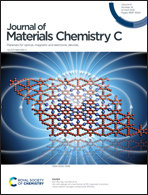Recent advances in poly(ionic liquid)s for electrochromic devices
Abstract
Electrochromic devices (ECDs), whose optical properties (transmittance, absorbance, reflectance, etc.) can be adjusted reversibly by using applied voltages, have been widely studied to be used in the fields of energy-saving smart windows, automobile rearview mirrors and electronic displays, due to their unique energy-saving and eye-friendly properties. However, many insurmountable barriers exist in ECDs, including non-ideal switching performances, complex device structures and complicated preparation processes, which restrict their commercial progress. The electrolytes as indispensable components of the ECDs provide essential ions to promote the electrochromic reactions and balance the residual charges, which influence the switching performance. Compared with traditional electrolytes of solid organic/inorganic salts and ionic liquids (ILs), poly(ionic liquid)s (PILs), which inherit the advantages of both polymers and ILs, have been regarded as one of the most promising candidates to be the electrolytes of ECDs, especially in the last five years. Herein, in this review, the newly developed PILs with various structures have been summarized comprehensively and systematically, and the positive influences on ECDs with the application of PILs, as well as the intrinsic mechanisms, have been discussed in detail. Besides, the problems faced and possible solutions have been proposed. Finally, based on the recent advances in PILs for ECDs, the future development prospects have been presented.

- This article is part of the themed collection: Journal of Materials Chemistry C Recent Review Articles


 Please wait while we load your content...
Please wait while we load your content...